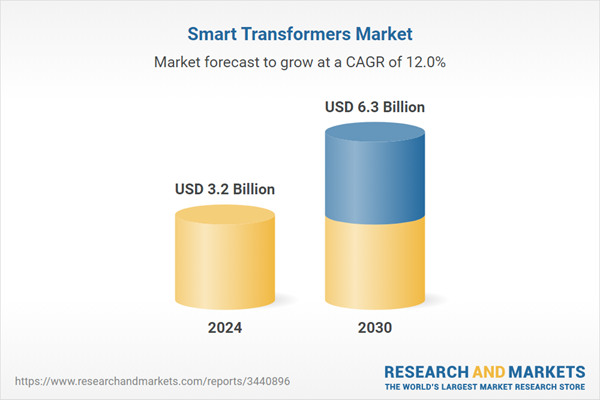The global market for Smart Transformers was valued at US$3.2 Billion in 2024 and is projected to reach US$6.3 Billion by 2030, growing at a CAGR of 12.0% from 2024 to 2030. This comprehensive report provides an in-depth analysis of market trends, drivers, and forecasts, helping you make informed business decisions. The report includes the most recent global tariff developments and how they impact the Smart Transformers market.
In specific setups like microgrids, smart transformers play an essential protective role at the Point of Common Coupling (PCC), managing the active power exchanged with the utility grid to safeguard electrical equipment from power fluctuations. This feature is vital during unstable grid conditions, helping maintain stability and protect sensitive equipment. The widespread use of smart transformers in rural network applications is also notable, as they enhance connectivity and data sharing across vast distances through power line communication systems. These systems are instrumental in managing distributed energy resources and integrating renewable sources into the grid effectively. Moreover, the design and integration of power converter cells within smart transformers are crucial for reducing core size, isolating different voltage levels, and minimizing energy losses, thus optimizing transformer performance and efficiency.
Smart transformers significantly improve power quality by providing a unity power factor and delivering sinusoidal currents under non-linear loads, thus protecting power systems from load disturbances like harmonics, transients, and voltage sags. They are integral to reducing grid losses and enhancing the reliability of power supply by ensuring consistent energy distribution even under unbalanced load conditions. The growth of the smart transformer market is driven by several factors, including aging infrastructure needing replacement, increased integration of renewable energy necessitating grid modernization, and a growing global energy demand. Other drivers include enhanced grid security and reliability, supportive regulatory policies, economic incentives for adopting green technologies, rising consumer expectations for reliable and sustainable energy, and advancements in digital technologies like IoT, AI, and machine learning that bolster smart transformer capabilities. Furthermore, the need for improved power quality, demand response management, rapid urbanization, and the necessity for interoperability among diverse energy systems are also significant factors promoting the adoption and development of smart transformers. These elements collectively underscore the essential role of smart transformers in the evolving landscape of global energy distribution, highlighting their importance in meeting current and future energy challenges efficiently and sustainably.
Segments: Type (Distribution Transformers, Power Transformers, Specialty Transformers, Instrument Transformers); Application (Smart Grid, Traction Locomotive, Electric Vehicle Infrastructure, Other Applications).
Geographic Regions/Countries: World; United States; Canada; Japan; China; Europe (France; Germany; Italy; United Kingdom; and Rest of Europe); Asia-Pacific; Rest of World.
The analysts continuously track trade developments worldwide, drawing insights from leading global economists and over 200 industry and policy institutions, including think tanks, trade organizations, and national economic advisory bodies. This intelligence is integrated into forecasting models to provide timely, data-driven analysis of emerging risks and opportunities.
Global Smart Transformers Market - Key Trends and Drivers Summarized
The energy sector is undergoing a significant transformation with the integration of advanced technologies and a growing adoption of renewable energy sources. Central to these developments are smart transformers, which have become increasingly critical in managing the complexities of modern electric distribution grids. These devices exceed the capabilities of traditional transformers by offering enhanced management features and greater efficiency. Equipped with solid-state technologies, smart transformers can independently regulate voltage and maintain optimal voltage levels, ensuring a stable and optimized power supply across the grid. They are particularly effective in large commercial facilities, where their ability to use energy more cost-effectively is crucial. Additionally, their capability to communicate continuously with the smart grid allows for remote administration and real-time feedback, making them proactive agents in voltage regulation and energy consumption minimization.In specific setups like microgrids, smart transformers play an essential protective role at the Point of Common Coupling (PCC), managing the active power exchanged with the utility grid to safeguard electrical equipment from power fluctuations. This feature is vital during unstable grid conditions, helping maintain stability and protect sensitive equipment. The widespread use of smart transformers in rural network applications is also notable, as they enhance connectivity and data sharing across vast distances through power line communication systems. These systems are instrumental in managing distributed energy resources and integrating renewable sources into the grid effectively. Moreover, the design and integration of power converter cells within smart transformers are crucial for reducing core size, isolating different voltage levels, and minimizing energy losses, thus optimizing transformer performance and efficiency.
Smart transformers significantly improve power quality by providing a unity power factor and delivering sinusoidal currents under non-linear loads, thus protecting power systems from load disturbances like harmonics, transients, and voltage sags. They are integral to reducing grid losses and enhancing the reliability of power supply by ensuring consistent energy distribution even under unbalanced load conditions. The growth of the smart transformer market is driven by several factors, including aging infrastructure needing replacement, increased integration of renewable energy necessitating grid modernization, and a growing global energy demand. Other drivers include enhanced grid security and reliability, supportive regulatory policies, economic incentives for adopting green technologies, rising consumer expectations for reliable and sustainable energy, and advancements in digital technologies like IoT, AI, and machine learning that bolster smart transformer capabilities. Furthermore, the need for improved power quality, demand response management, rapid urbanization, and the necessity for interoperability among diverse energy systems are also significant factors promoting the adoption and development of smart transformers. These elements collectively underscore the essential role of smart transformers in the evolving landscape of global energy distribution, highlighting their importance in meeting current and future energy challenges efficiently and sustainably.
Report Scope
The report analyzes the Smart Transformers market, presented in terms of units. The analysis covers the key segments and geographic regions outlined below.Segments: Type (Distribution Transformers, Power Transformers, Specialty Transformers, Instrument Transformers); Application (Smart Grid, Traction Locomotive, Electric Vehicle Infrastructure, Other Applications).
Geographic Regions/Countries: World; United States; Canada; Japan; China; Europe (France; Germany; Italy; United Kingdom; and Rest of Europe); Asia-Pacific; Rest of World.
Key Insights:
- Market Growth: Understand the significant growth trajectory of the Distribution Transformers segment, which is expected to reach US$2.9 Billion by 2030 with a CAGR of a 12.8%. The Power Transformers segment is also set to grow at 12.0% CAGR over the analysis period.
- Regional Analysis: Gain insights into the U.S. market, valued at $861.8 Million in 2024, and China, forecasted to grow at an impressive 10.9% CAGR to reach $950.3 Million by 2030. Discover growth trends in other key regions, including Japan, Canada, Germany, and the Asia-Pacific.
Why You Should Buy This Report:
- Detailed Market Analysis: Access a thorough analysis of the Global Smart Transformers Market, covering all major geographic regions and market segments.
- Competitive Insights: Get an overview of the competitive landscape, including the market presence of major players across different geographies.
- Future Trends and Drivers: Understand the key trends and drivers shaping the future of the Global Smart Transformers Market.
- Actionable Insights: Benefit from actionable insights that can help you identify new revenue opportunities and make strategic business decisions.
Key Questions Answered:
- How is the Global Smart Transformers Market expected to evolve by 2030?
- What are the main drivers and restraints affecting the market?
- Which market segments will grow the most over the forecast period?
- How will market shares for different regions and segments change by 2030?
- Who are the leading players in the market, and what are their prospects?
Report Features:
- Comprehensive Market Data: Independent analysis of annual sales and market forecasts in US$ Million from 2024 to 2030.
- In-Depth Regional Analysis: Detailed insights into key markets, including the U.S., China, Japan, Canada, Europe, Asia-Pacific, Latin America, Middle East, and Africa.
- Company Profiles: Coverage of players such as ABB Ltd., Bharat Heavy Electricals Ltd., Eaton Corporation PLC, General Electric Company, Schneider Electric SA and more.
- Complimentary Updates: Receive free report updates for one year to keep you informed of the latest market developments.
Some of the 73 companies featured in this Smart Transformers market report include:
- ABB Ltd.
- Bharat Heavy Electricals Ltd.
- Eaton Corporation PLC
- General Electric Company
- Schneider Electric SA
- Siemens AG
Tariff Impact Analysis: Key Insights for 2025
Global tariff negotiations across 180+ countries are reshaping supply chains, costs, and competitiveness. This report reflects the latest developments as of April 2025 and incorporates forward-looking insights into the market outlook.The analysts continuously track trade developments worldwide, drawing insights from leading global economists and over 200 industry and policy institutions, including think tanks, trade organizations, and national economic advisory bodies. This intelligence is integrated into forecasting models to provide timely, data-driven analysis of emerging risks and opportunities.
What’s Included in This Edition:
- Tariff-adjusted market forecasts by region and segment
- Analysis of cost and supply chain implications by sourcing and trade exposure
- Strategic insights into geographic shifts
Buyers receive a free July 2025 update with:
- Finalized tariff impacts and new trade agreement effects
- Updated projections reflecting global sourcing and cost shifts
- Expanded country-specific coverage across the industry
Table of Contents
I. METHODOLOGYII. EXECUTIVE SUMMARY2. FOCUS ON SELECT PLAYERSIII. MARKET ANALYSISIV. COMPETITION
1. MARKET OVERVIEW
3. MARKET TRENDS & DRIVERS
4. GLOBAL MARKET PERSPECTIVE
UNITED STATES
CANADA
JAPAN
CHINA
EUROPE
FRANCE
GERMANY
ITALY
UNITED KINGDOM
REST OF EUROPE
ASIA-PACIFIC
REST OF WORLD
Companies Mentioned (Partial List)
A selection of companies mentioned in this report includes, but is not limited to:
- ABB Ltd.
- Bharat Heavy Electricals Ltd.
- Eaton Corporation PLC
- General Electric Company
- Schneider Electric SA
- Siemens AG
Table Information
| Report Attribute | Details |
|---|---|
| No. of Pages | 143 |
| Published | April 2025 |
| Forecast Period | 2024 - 2030 |
| Estimated Market Value ( USD | $ 3.2 Billion |
| Forecasted Market Value ( USD | $ 6.3 Billion |
| Compound Annual Growth Rate | 12.0% |
| Regions Covered | Global |









